Comparing the newest offerings in the 30-foot range
Published on July 17th, 2014
Two of the finest boat builders in USA have recently launched new offerings in the 30-foot range. Both the C&C 30 One Design and the J/88 have been reviewed by frequent Scuttlebutt contributor Don Finkle of RCR Yachts, who has provided a thorough and fair assessment of these similar yet different boats. For the sake of full disclosure, RCR Yachts represents both brands, but their comments and opinions are strictly their own, and are no way influenced by the owners and builders of the boats. Enjoy…
C&C 30 vs J/88: There are obvious similarities between these two new boats but also some key differences. In most cases a sailor will begin by looking at both and then rather quickly decide that one is a better fit for them than the other. One of our tasks here is to help in that process.
Similarities: Both are modern designs geared to performance and close in length, the C&C being 30’ LOA and the J/88 29’. They both have an inboard diesel saildrive with folding prop. Each has a Hall spars twin spreader carbon mast and aluminum boom, and Hall standing and running rigging packages. Each is built with modern resin infusion cored construction in the hull and deck. The base prices of both boats are almost exactly the same. Both have all the ballast in the keel bulb. They are each built in RI in plants less than 10 miles apart by experienced sailboat builders. Both have minimum overlap headsails and asymmetric spinnakers set on sprits.
Other similarities include LED lighting, long clean cockpits with open transoms, two settee berths with cushions and the option for two more berths (V berth in the J, quarterberths in the C&C), standard race hardware and spinnaker rigging including vang, Cunningham, adjustable backstay(s), etc. Due to similar size and pricing there will naturally be some comparison shopping. Finally both are sold through dealer networks which broaden distribution and create the option for taking trades, provides local servicing and demo sailing availability, etc.
Differences: It does not take too long before one realizes that despite the many areas where the two designs are similar, there are also plenty of differences. The result is that the two boats are aimed at somewhat different markets. While both are performance boats that will be used a lot for racing, the C&C is decidedly more “racy” and the J has much more interior and seats in the cockpit. We will go out on a limb and state that the age of the typical C&C 30 buyer will probably be younger than the bulk of the J/88 buyers.
Here are some areas of contrast:
Rudder: C&C is inboard, J is outboard, but each is easily removed.
Sprit: Both carbon by Hall. C&C has a tapered sprit that is fixed while sailing but is easily removable at the dock. The J/88 has the typical retractable sprit common on other J models.
Keel: C&C has a carbon fiber fin with a T-bulb made of lead, finished in white epoxy paint. The J/88 keel has a J-shaped fiberglass fin around a stainless steel backbone with all the lead in bulb. It is finished in smooth white gelcoat. The J/88 keel is fixed, the C&C partially retracts to reduce height for trailing.
Design: Marks Mills did the C&C and Al & Rod Johnstone drew the J/88.
Dimensions: The C&C is a bit longer, a bit wider, a bit longer on the waterline and has a foot more draft.
Weight: The C&C is 1,100 pounds lighter with almost the same ballast as the J/88.
Sail area: is greater on the C&C with all three sails being larger.
Engine: The C&C has a 12 HP Volvo, the J a 14HP Yanmar, both saildrives with folding props.
Tiller: Carbon fiber on the C&C and Molded Fiberglass on the J, both have extensions.
Core: The C&C uses foam core in hull and deck, the J balsa in the hull and foam in the deck.
Mast Step: Keel step on the C&C adjusted by turnbuckle, fixed tabernacle on the deck for the J.
Forestay: C&C has Dyneema forestay for hanked on jib, J/88 has a below deck Harken furler.
Backstay: Both Dyneema; C&C has twin 2:1 backstays led to winches aft. J/88 has single with cascading double-ended tackle.
Head: the C&C has a small self-contained unit, with the option for a head with holding tank. The J/88 has a standard marine head with holding tank.
Winches: C&C has 2 for sheets, 2 for backstays; J/88 has 2 cabintop and 2 sheet winches in cockpit.
Jib leads: C&C has all-axis lead adjustment led under deck, J/88 has adjustable Harken tracks.
Vang: 16:1 Spectra on the C&C, Hall rigid Quick Vang on the J.
Forward hatch: Offset round on the C&C, centerline square on the J.
Main Companionway hatch: C&C’s is offset, centerline on the J.
Sink: none on the C&C, standard on the J.
Cooler: none on the C&C, standard on the J.
Deck: The C&C has a flush deck with no coachroof or side ports but one aft facing port into the cockpit. The J has a cabintop with two fixed side ports and optional aft ports into the cockpit.
Interior: Here is where the boats differ considerably. The C&C is more Spartan and open from front to back. It has decidedly less headroom. The forward area is open but there is a lot of area aft on either side and plenty of space for the optional quarterberths. The head is a very small self-contained plastic unit that pumps out through the deck. Leave your modesty at the dock. The J has a more conventional interior with headroom to walk bent over and a sizable bulkhead between the head and the main cabin plus a curtain so there is some basic privacy. The V berth is an option that is almost always ordered. There is storage behind the main cabin backrests, some cubbies and shelves, a mini chart table to starboard and sink area to port. Under the cockpit there is plenty of storage with access through one seat locker. You could cruise the J if you are realistic about the limitations of space in a 4,900 lb 29 foot performance boat where weight is a consideration. The berths are plenty large and it is not claustrophobic below.
Colors: both have standard white hulls with choice of waterline colors and optional 2 tone decks. Each also offers the option of black powder-coating on the standard rails and stanchions (really sharp). Hull colors other than white are only available by painting after construction. Spars are black.
Well? Both boats will appeal primarily to racers but can certainly be daysailed and slept on overnight. The C&C is clearly more of a Grand Prix hotrod but the J is no slouch. The J is better suited if you plan to spend any time below. Both are capable of overnight races, unlike some other boats that are really inshore day-racers. The quality of both is excellent in our opinion, the C&C being more high-tech, the J having more amenities, cockpit seats, and storage. We have been sailing the J/88 and really enjoying it and the owners love their boats. We have yet to sail the C&C and can’t wait; the initial reports from very good sailors have been glowing.
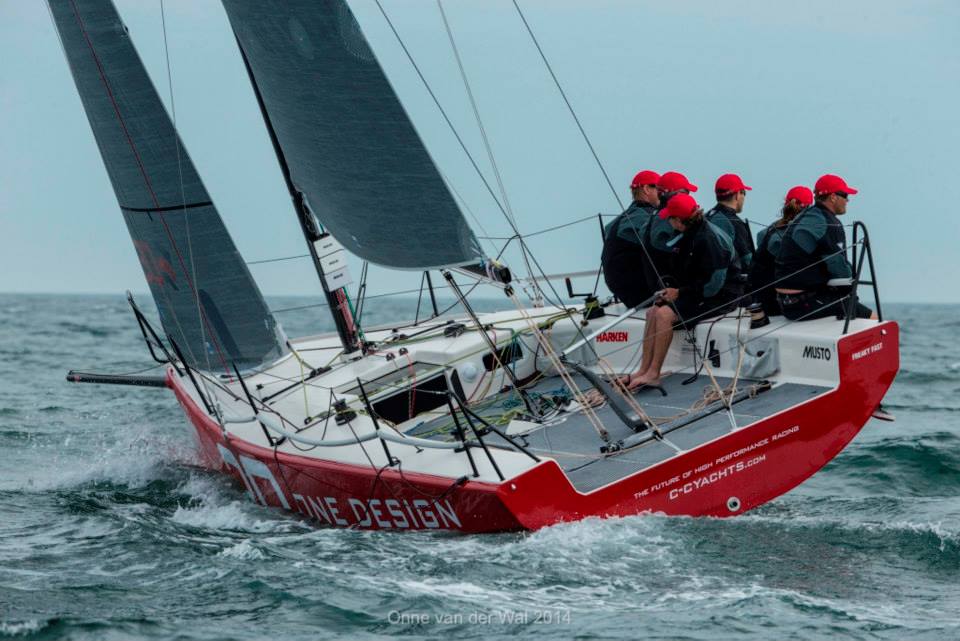 C&C 30 Build Observations:
C&C 30 Build Observations:
Since I have not sailed the boat yet we can only comment on what we have seen during construction. I was able to follow the build on several trips to the factory in RI. This allowed me to see the construction process from the very beginning when it was just some lines on paper to the almost-finished boat that was a couple of days from being launched. It also gave me the opportunity to speak to the guys building this rocket so they could explain what they were doing and why. The one feeling I can say has stayed with me right from the beginning is the obvious quality and attention to detail that these guys have put into the C&C 30 One Design. It is really, really well made and finished.
The factory where the NEW C&Cs are being built is the one where thousands of Jboats, Alerions, True Norths, and various other boats were built over these many years. The depth of talent and experience in that building is considerable and is rarely found elsewhere. The new owners of US Watercraft have opened their pocketbooks to bring in some truly skilled engineers, boatbuilders, architects and supervision to add to the team already in place. Despite all the other projects underway there they have put forth what is clearly a labor of love with the C&C 30. Dealers and builders are alike in that we make our money selling cruising boats but we get our kicks out of building and selling race boats. The guys at USW clearly enjoyed creating the C&C 30.
When we talk about the obvious quality of construction of the C&C 30 we are not speaking of gloss varnished hand crafted interior joinery, although USW is very capable of that in their other products. Instead they take great care during the construction of the hull and deck so that the parts are at minimum weight and maximum consistency. Everything they put into hull #1 was weighed to make sure they are hitting their numbers. This is a high performance boat so what is there suits that purpose and there is nothing that is not needed. Being near the yachting Mecca of Newport has the added benefit of a wealth of world-class sailing talent who happen to be friends of the USW folks. These rock stars have been all over the C&C 30 providing invaluable input on the deck layout, hardware and rigging placement, etc. So the boat is not only very carefully and skillfully made, it is also set up with the advice of the best brains in the game today. The same people sailing and tweaking TP52s and Volvo 70s have provided counsel on how to set up the C&C 30 for maximum sailing efficiency. This relates to the way the sails are trimmed, crew ergonomics, reduction in unnecessary weight and complexity, and so forth.
When you are building an all-new boat as opposed to an update of an older one you are not constrained by the limitations of the prior design or tooling. Since the C&C 30 is a clean-sheet design being mother-henned by guys that know a ton about building race boats (i.e. Farr 30s and 40s, etc), they can do a lot of cool things. I noted for instance that under the angle brace feet of the lifeline stanchions they have round carbon pads that not only look awesome but spread the load. The gloss-finished carbon tiller is a work of art, with the new colored C&C logo molded in. The jib sheet adjusters are led under deck which further reduces clutter on a really clean deck. There is an angled molded FRP pedestal on the cockpit sole where all the mainsail control lines are conveniently located for the main trimmer. The sprit is a round tapered carbon spar that slides into a centerline socket at the stem. Once in place it is secured by a Spectra line that is cleated inside the hull. For docking or transport it can be easily slid back out.
The foils are made right at USW, the keel is a carbon fin with a lead T-bulb and the rudder made of E glass with variable density foam and Vinylester resin. The keel box inside the hull is very solidly made with carefully machined synthetic bearings (I forget the name the engineer had for them) that give the keel a nice tight fit, no rattling around. The keel is designed to be raised for transport to reduce the air draft of the boat on the trailer. There is an inspection port in the deck over the keel for a single point lift through the deck. The keel does not come through the deck. The rudder may be left in during transport or easily removed and stowed inside the boat.
The spars and standing and running rigging are made nearby at Hall Spars and rigging, and again the close proximity to the USW plant makes it easy for exchange of information during the prototype process. It is much easier for those designing and manufacturing components to be able to see the boat in person, sail on it, and meet face to face regularly with the boatbuilders and engineers. And all of this is built in the USA!
J/88 Build Observations:
We had been asking Jboats for a new model in the 28-30 foot range for a number of years. The 33 foot J/100 was an excellent boat for us and for our customers, but it was a bit larger than what we needed and the price crept up. Further, it was never intended as a racing boat despite the fact that all of our customers (and ourselves) raced our 100s. We asked for a new model that was a bit smaller yet faster for its size, being confident that it would be a hit. The Johnstones listened and so the 29’ J/88 was born in 2013. Because we were such vocal proponents we were promised and received hull #2 late last July. This gave us an opportunity to sail the boat and take orders before most other dealers, with the result that we now have five J/88s sailing here on the Lower Niagara River.
This is supposed to be about the build of the boat so let’s start with who builds it and where. CCF is located in Bristol, RI, in close proximity to a number of other marine industries including Hall Spars. The plant is modern and clean and the owner and his loyal workforce will never be seen standing around. They currently build various Jboats models including the 70, 88, 95 and 111, along with others including their own line of North Coast power boats. When we began to sell J/70s like hotcakes (we are up to about 30 boats sold here so far at RCR) I admit I was a bit nervous because when you are selling that many boats you worry about the potential warranty and service obligations. However, the boats we have gotten from CCF so far have been close to trouble-free, including all those 70s and several 111s. The CCF folks produce boats of consistent quality and their on-time completion record is excellent. They don’t offer many options and they don’t get into fancy woodwork, they specialize in fiberglass lamination and resin infusion. We can honestly say that we have been impressed with the boats they have shipped to us and they are super to work with.
CCF uses fiberglass materials that are pre-cut in the form of kits when they arrive, so each hull or deck gets exactly the same material for use in lay-up. The hulls and decks are infused which results in high glass to resin ratios and a high-quality and stronger, light weight part. The gelcoat finish on the boats we have gotten from them is also consistently good without the cracks and chips we see on many other boats. Only a couple of tiny air voids on all the boats so far.
Spars for the J/88s are made around the corner at Hall Spars and Rigging. This includes a black-painted double swept-spreader carbon mast and aluminum boom. The sprit is carbon and retracts into the hull as on most new Jboat models of the last 20+ years. Standing rigging is by Hall, as is the low stretch running rigging package which is extensive and all color-coded. Standard rigging includes: two spinnaker sheets, three halyards, tack line, pole control line, jib sheets, in-haulers, adjustable jib cars, cascading backstay trimmed P&S, traveler controlled P&S, coarse and fine mainsheet tackles, Cunningham, internal outhaul, reef line, jib furling line, and probably something else I have missed. A Harken below-deck jib furler is standard as is a Hall Quick Vang. The masthead crane is longer to accommodate the square head mainsail.
The rudder is outboard transom-hung and very deep for lots of control. The tiller is molded fiberglass and a telescoping Spinlock extension is standard. There is zero external teak to take care of! The keel is built around a stainless steel fabricated backbone with all the lead ballast molded around the bottom. This puts the entire lead casting inside the bulb for maximum leverage. The keel itself is made from two molded fiberglass skins, much the same as rudders are built, with the backbone and lead inside. So the outside of the keel is finished in smooth white gelcoat which will reduce maintenance. The bulb is swept aft so this is known as a J shaped keel, not a T keel, so there is no part of the bulb protruding forward of the vertical leading edge.
One of the design concepts behind the J/88 was that it should be practical for a variety of uses, not simply racing. So on deck you will find an anchor locker forward, an opening cockpit seat on the port side, and P&S seats in the forward end of the cockpit with some low backrests. Daysailing and limited cruising is very much in the realm of the J/88. The traveler and mainsheet are set up so that you could single hand the boat, the helmsman could trim the main, or you can have a dedicated main trimmer. The jib tacks very easily so usually one person can do that job alone. There is plenty of room aft of the traveler to move about the cockpit. The non-skid is aggressive which we personally like, and the side decks aft of the shrouds are clear of toerails for comfortable hiking (if there is such a thing). Adding to the comfort of the crew on the rail, the lower lifeline is a bit lower, not evenly spaced us usual, so there is more room to move your torso over it and under the upper lifeline. The stanchions have welded on angle braces and are very sturdy for grabbing onto. Our guilty pleasure is the black powder coated stanchion and rail option which is not cheap but the cool factor is awesome!
Due to the multi-purpose nature of the J/88 it has a usable interior. The headroom is not full standing for us tall guys but you can move around without difficulty. One day we were below waiting for the launch and there were four big guys sitting in the salon and it was very comfortable, no problem with your head fitting under the side decks and there are molded backrests behind the settees with shelves above. There are stowage cubbies in the backrests, and small cabinets P&S forward of the settees. To starboard is the electrical panel outboard of a little nav area with opening top locker and another locker below. To port there is a sink, and lockers outboard and below. Table? Who needs a table? You won’t find one. There are two fixed ports so you can see outside and you will want the two small opening ports in the aft face of the coachroof facing into the cockpit, an option ordered on all the boats we have taken so far. The main cabin bulkhead if fiberglass finished in white gelcoat and separates the main cabin from the forward part of the boat. There is a curtain that is included as standard but we don’t use it. The head is tucked outboard to port so there is some privacy without it. The head is a real marine head with holding tank and there is storage outboard. Opposite the head is a stowage area for bags and the like. The forward end of the boat comes with a molded fiberglass berth top to which you can optional V berth cushions (so far everyone has done so). Under the cockpit is where we stow loose gear, there is quite a bit of room back there.
The engine is a 14HP Yanmar diesel saildrive with a geared folding prop. It is more power than the boat needs but it is nice to be able to go fast when you want to. If you are not familiar with saildrives you will be pleased with the lack of vibration, no worry about stuffing box leaks, no shaft to align, and the prop is far forward of the rudder to cut down on cavitation. Because there is no angled shaft the engine sits level which is better for the oil circulation. The engine starts instantly and is miserly on fuel. A super set-up all around.
How does it sail? That is never easy to quantify in words which is why we always encourage you to come and see for yourself. Stability is good both laterally and directionally. The rudder has lots of bite. Visibility forward is very good due to the low coachroof and non-overlapping jib. Once that big kite is up the visibility is not as good, true of all a-sail boats, especially those with lower freeboard. The boat seems to cut through waves well and behaves upwind and down. One pleasant surprise we discovered was how well the J/88 sails with only the main or jib up. The balance is excellent and the helm light. With just the main up you can’t sail quite as close to the wind obviously but the boats steers and handles just fine and the speed is pretty darn good. Nice for single handed daysailing. The PHRF rating in most areas is 87, so that gives you a yardstick of relative performance.
The Johnstones have had a most successful program for years, basing new designs on their own experience as sailors, listening to customers and dealers, and using local RI build talent and suppliers. The J/88 is not a revolutionary product but it was not intended to be. It shares the same thinking as their excellent J/111 and J/70 designs which have proven to be successful in terms of sales and on the race course. There is a need for a good modern boat in this size and price range utilizing the design and construction expertise that they have refined over the years. It is a versatile boat that you can race, daysail, short-handed sail and cruise for short periods. Our own feeling after sailing the boat since last summer is they have hit on another winner. And it is built in the USA!
Background:
RCR Yachts has been a fixture on the Great Lakes sailing scene for over 40 years. As one of North America’s most experienced and respected full-service sailboat operations, they sell new and used sailboats and powerboats, operate several boat yards and marinas, and provide service and repair work. Their multiple locations serve Lake Erie and Lake Ontario, as well as nearby inland waters. http://www.rcryachts.com/default.asp




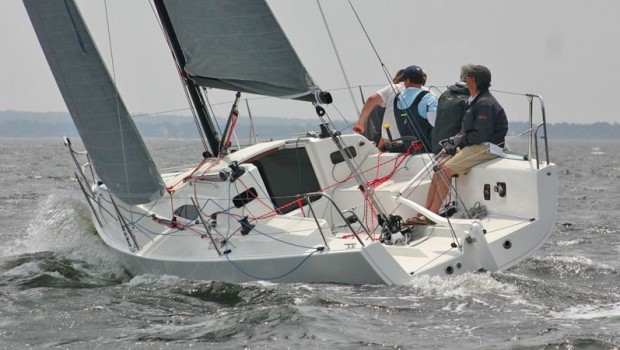

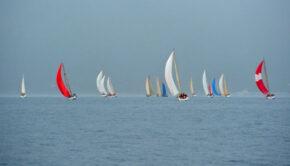
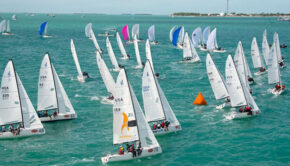
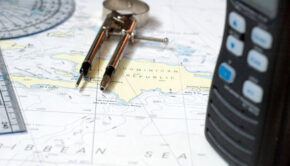

 We’ll keep your information safe.
We’ll keep your information safe.